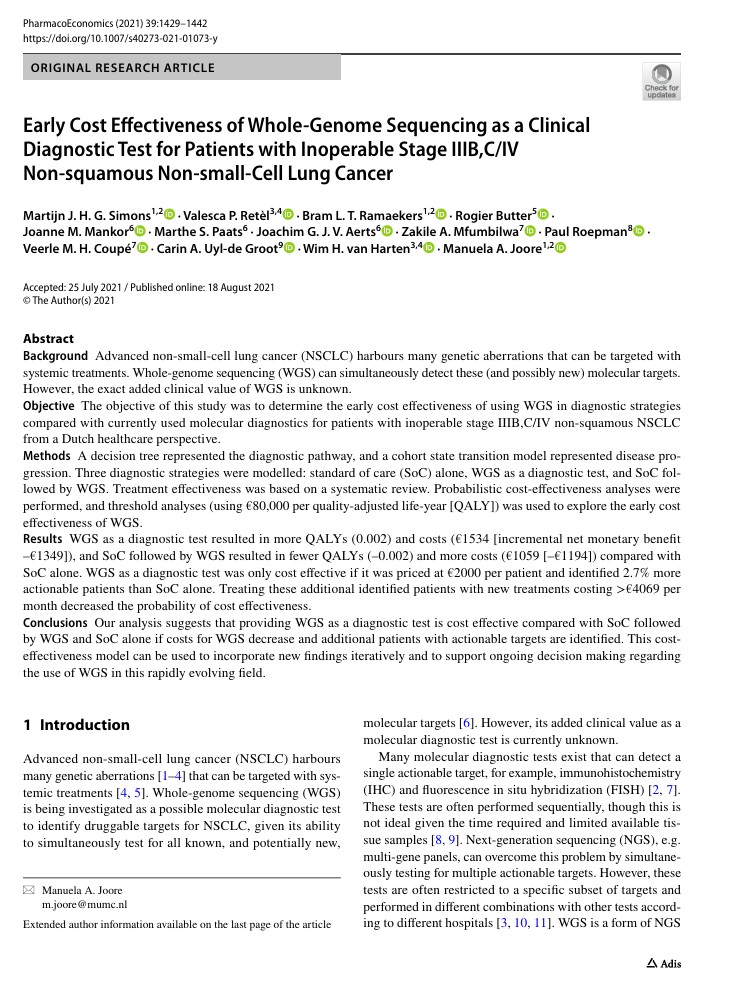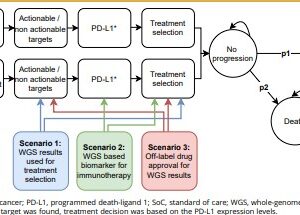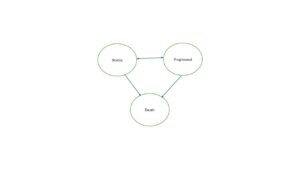Your cart is currently empty!
Early cost-effectiveness model of whole genome sequencing as a molecular diagnostic test versus standard of care in locally advanced and metastatic (Stage IIIB,C/ IV) non-squamous non-small cell lung cancer
All your purchased models will be available under your account under “Dashboards”
Disease Area (Primary)
NSCLC
First Developed
07/25/2021
Last Developed
08/18/2021
Software Used
Microsoft Excel
Model Sponsor
Government agency
Intervention
whole_genome_sequencing
Model Validation Score
– %
Coming Soon In Phase II: You will be able to pay a fee to download the CADTH Tool for your model which includes subaggregated scores.
Results
WGS as a diagnostic test resulted in more QALYs (0.002) and costs (€1534 [incremental net monetary benefit –€1349]), and SoC followed by WGS resulted in fewer QALYs (–0.002) and more costs (€1059 [–€1194]) compared with SoC alone. WGS as a diagnostic test was only cost effective if it was priced at €2000 per patient and identified 2.7% more actionable patients than SoC alone. Treating these additional identified patients with new treatments costing >€4069 per month decreased the probability of cost effectiveness.
Conclusion
Our analysis suggests that providing WGS as a diagnostic test would be cost effective compared with SoC followed by WGS and SoC alone if costs for WGS decreased and additional patients with actionable targets were identified. This cost-effectiveness model can be used to incorporate new findings iteratively and to support ongoing decision making regarding the use of WGS in this rapidly evolving field.
Source File(s)
Model Review
Only visible for the model owner
Summary
Validation Score
– %
Internal Comments
–
Full review
| 01 Model Built Reflective | yes |
|---|---|
| 02 Model Subgroups | yes |
| 03 Model Assesses all comparators | yes |
| 04 Model Incorporates costs | yes |
| 05 Model assesses all outcomes | yes |
| 06 Model structure validated by experts | yes |
|---|---|
| 07 Model aligns with or justifies deviation from previous models | yes |
| 08 Time in health states | yes |
|---|---|
| 09 Consistency with time in states | yes |
| 10 Clinical events extractable | yes |
| 11 Consistency with number of clinical events | yes |
| 12 Impact of adverse events | yes |
| 13 Consistency with adverse events | yes |
| 14 Life-years reported | yes |
| 15 Impact on mortality | yes |
| 16a Reasons for mortality differences | yes |
| 16b Reasons for mortality differences | yes |
| 16c Reasons for mortality differences | yes |
| 16d Reasons for mortality differences | yes |
| 17 Main driver of incremental life-years | yes |
| 18 Consistency with mortality rates | yes |
| 19 No technology-specific utilities used | yes |
| 20 Main driver of cost-effectiveness | yes |
| 21 Extrapolation methods identified | yes |
| 22 Adjustable time horizon | yes |
| 23 Double counting avoided | yes |
| 24 Surrogate vs final outcomes alignment | yes |
| 25 Flexibility for treatment effect waning | yes |
| 26 Access to deterministic and Monte Carlo results | yes |
|---|---|
| 27 Clear trace from inputs to outcomes | yes |
| 28 Macros used only for simulation/navigation (Excel) | yes |
| 29 QALY equivalence across technologies | yes |
|---|---|
| 30 Extreme effectiveness impact on QALY | yes |
| 31 Slight effectiveness impact on QALY | yes |
| 32 Increased mortality lowers QALYs | yes |
| 33 Reduced mortality increases QALYs | yes |
| 34 Increased baseline risk lowers QALYs | yes |
| 35 Reduced baseline risk increases QALYs | yes |
| 36 Zero mortality leads to equal life-years | yes |
| 37 Cost change affects only total costs | yes |
| 38 Utilities = 1 makes QALYs equal life-years | yes |
| 39 No discounting increases QALYs/costs | yes |
| 40 Higher discounting decreases QALYs/costs | yes |
| 41 Shorter time horizon lowers QALYs/costs | yes |
| 42 Inputs switchable across alternatives | yes |
| 43 Cost-QALY correlation across simulations | yes |
| 44 Strong cost correlation from Monte Carlo | yes |
| 45 Strong QALY correlation from Monte Carlo | yes |
| 46 Deterministic ≈ Probabilistic results | yes |
| 47 Backward trace from results to inputs | yes |
|---|---|
| 48 Backward trace from results to inputs | yes |
| 49 No use of non-transparent Excel functions | yes |
|---|---|
| 50 No hidden sheets, rows, or columns | yes |
| 51 No custom formulas inside VBA macros | yes |
| 52 Parameters persist after macros | yes |
| 53 Transparent input structure in single worksheet | yes |
| Private internal comments | – |



